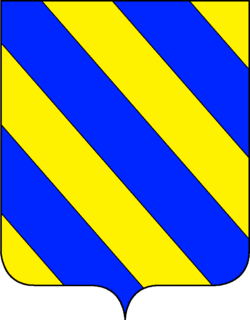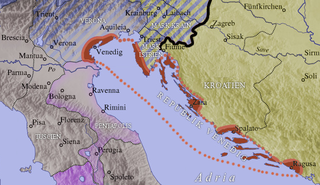This article has an unclear citation style.(August 2021) |
Francesco Apostoli (circa 1755 - February 1816) was an Italian bureaucrat and travel writer.
This article has an unclear citation style.(August 2021) |
Francesco Apostoli (circa 1755 - February 1816) was an Italian bureaucrat and travel writer.
Francesco was born a Venetian citizen, and as a young adult worked as a secretary in the Venetian republic. He however left his position and country and travelled to France and Germany. He befriended the Count Maximilian Joseph von Lamberg and stayed at his palace for over a year in Landshut. The Count, known as a writer, was helped by Apostoli to compile a second volume of his opus Le Memorial d'une Mondaine. Returning to Venice, he adopted the pseudonymous pen-name and published in 1777 idiosyncratic letters to Lozembrune (1751-1801) about travels under the title Lettres et Contes sentimentaux de George Wanderson. The text also contained two semi-autobiographic short novels: Storia di Andrea and Saggezza della follia. In 1782, he published Saggio per servire alla storia de'viaggi filosofici e de' principi viaggiatori. However a few years later, even though married, he embarked on more travels only to find himself upon returning to Venice, under suspicion for indiscreet communications with the Republican French ambassador of Genoa, Tilly, and in 1794, arrested and condemned to work in Corfu under the local provveditore. [1] [2] Widowed of his first wife, he remarried.
He moved to Milan there he was appointed by the newly formed Italian Republic as consul for Ancona. He did not reach that town, and was captured by the Austrian army and exiled to Dalmatia, he wrote about this imprisonment and exile in Lettere Sirmiensi per servire alla deportazione de' cittadini Cisalpini in Dalmazia ed Ungheria. In 1800, again in Milan, he published Rappresentazione del secolo XVIII. He was appointed as ambassador of the Republic of San Marino to the Napoleonic Government in Paris. His posting was not very happy: Piccola repubblica, piccolo rappresentate (small republic, small representative) he would tell those he met. In Paris, he composed l'Histoire de la révolution par un Étranger. This publication apparently angered the authorities, which forced him to leave France. In Italy, he obtained government positions in the police, including in Venice. He began to write Storia dei Galli, Franchi, e Francesi. He then obtained a post as inspector "partimentali" to a library and printing press of Padua. He began to write for the theater, writing two comedies: E tutto un momento and Merenda all Zuecca. He died poor in Venice. [3]

The Italian Wars, often referred to as the Great Wars of Italy and sometimes as the Habsburg–Valois Wars, were a long series of wars fought between 1494 and 1559 in Italy during the Renaissance. The Italian peninsula, economically advanced but politically divided among several states, became the main battleground for European supremacy. The conflicts involved the major powers of Italy and Europe, in a series of events that followed the end of the 40-year long Peace of Lodi agreed in 1454 with the formation of the Italic League.

Count Leopoldo Cicognara was an Italian artist, art collector, art historian and bibliophile.

The Duchy of Milan was an Italian state located in northern Italy. The duchy was created in 1395 by Gian Galeazzo Visconti, then the lord of Milan, and a member of the important Visconti family, that had been ruling the city since 1277.

The War of the League of Cambrai, sometimes known as the War of the Holy League and several other names, was a major conflict in the Italian Wars of 1494–1559. The main participants of the war, who fought for its entire duration, were France, the Papal States, and the Republic of Venice, joined at various times by nearly every significant power in Western Europe, including Spain, the Holy Roman Empire, England, the Duchy of Milan, the Republic of Florence, the Duchy of Ferrara, and Swiss mercenaries.

Contarini is one of the founding families of Venice and one of the oldest families of the Italian Nobility. In total eight Doges to the Republic of Venice emerged from this family, as well as 44 Procurators of San Marco, numerous ambassadors, diplomats and other notables. Among the ruling families of the republic, they held the most seats in the Great Council of Venice from the period before the Serrata del Maggior Consiglio when Councillors were elected annually to the end of the republic in 1797. The Contarini claimed to be of Roman origin through their patrilineal descendance of the Aurelii Cottae, a branch of the Roman family Aurelia, and traditionally trace their lineage back to Gaius Aurelius Cotta, consul of the Roman Republic in 252 BC and 248 BC.

Francesco Barbaro (1390–1454) was an Italian politician, diplomat, and humanist from Venice and a member of the patrician Barbaro family. He is interred in the Church of the Frari, Venice.
Giosafat Barbaro (1413–1494) was a member of the Venetian Barbaro family. He was a diplomat, merchant, explorer and travel writer. He was unusually well-travelled for someone of his times.

The Barbaro family was a patrician family of Venice. They were wealthy and influential and owned large estates in the Veneto above Treviso. Various members were noted as church leaders, diplomats, patrons of the arts, military commanders, philosophers, scholars, and scientists.

Apostolo Zeno was a Venetian poet, librettist, journalist, and man of letters.

The Republic of Venice, traditionally known as the Most Serene Republic of Venice, was a sovereign state and maritime republic in northeastern Italy, which existed for a millennium between the 8th century and 1797.

Gregorio Lazzarini was an Italian painter of mythological, religious and historical subjects, as well as portraits. One of the most successful Venetian artists of the day, a prominent teacher, and father to a significant school of painting, he is best known for having first trained Giambattista Tiepolo, who joined his workshop in 1710 at the age of fourteen. His own style was somewhat eclectic.

Domenico Morosini was the thirty-seventh doge of the Republic of Venice, reigning from 1148 until his death in 1156.

The Domini di Terraferma was the hinterland territories of the Republic of Venice beyond the Adriatic coast in Northeast Italy. They were one of the three subdivisions of the Republic's possessions, the other two being the original Dogado (Duchy) and the Stato da Màr.

Giovanni Battista Ramusio was an Italian geographer and travel writer.

The House of Loredan is a noble family from Venice which has played a significant role in shaping the history of the entire Mediterranean. A political dynasty, the family has throughout the centuries produced a number of famous personalities: doges, statesmen, magnates, procurators, providures, podestàs, military commanders, naval captains, church dignitaries, writers and lawyers.

Silvestro Valier or Valiero was the 109th Doge of Venice, reigning from his election on 25 February 1694 until his death six years later. The Morean War between the Republic of Venice and the Ottoman Empire, which had been ongoing since 1684, came to an end during Valier's reign as Doge, in January 1699.

Francesco Loredan was a Venetian statesman and magnate who served as the 116th Doge of Venice from 18 March 1752 until his death in 1762. He was a member of the noble House of Loredan, head of its Santo Stefano branch, and the only Doge to be awarded the Golden Rose by the Papacy.

The Giorgi or Zorzi were a noble family of the Republic of Venice and the Republic of Ragusa.

Eliodoro Bianchi was an Italian operatic tenor and later a prominent singing teacher. Born in Cividate al Piano and trained in Naples under Giacomo Tritto, he made his stage debut in 1793. Amongst the many roles he created during the course of his 40-year career were Baldassare in Ciro in Babilonia and the King of Sweden in Eduardo e Cristina, both of which were composed by Rossini expressly for Bianchi's voice. He retired from the stage in 1835 and spent his later years in Palazzolo sull'Oglio, where he died at the age of 75.

Girolamo Zane was a Capitano generale da Mar of the Venetian fleet during the War of Cyprus.